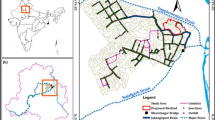Abstract
This paper presents a case study on the impact of the size and location of wetlands on watershed-scale flood control utilizing the Cypress Creek Watershed in Houston, Texas as the study area. Wetlands of different sizes were implemented at different locations (upstream, midstream, and downstream) of the watershed and corresponding hydrologic and hydraulic simulations were performed to investigate the impact that wetland size and location parameters have on downstream flood conditions. This study used HEC-HMS as the hydrologic model for the watershed, and HEC-RAS as the hydraulic model for rivers within the watershed. Wetlands were implemented in the HEC-HMS model as reservoirs. Simulation results indicate the more upstream wetlands are located within the watershed, the smaller the flood area, the shallower the flood depth, and the shorter the flood duration at the downstream region of the watershed. In addition, the downstream flood area, flood depth, and flood duration decrease as the size (storage capacity) of wetlands increases.










Similar content being viewed by others
References
Ameli A, Creed I (2019) Does wetland location matter when managing wetlands for watershed-scale flood and drought resilience? JAWRA Journal of the American Water Resources Association. https://doi.org/10.1111/1752-1688.12737
Ardiclioglu M, Kuriqi A (2019) Calibration of channel roughness in intermittent rivers using hec-ras model: case of sarimsakli Creek, Turkey, 1: 1080. https://doi.org/10.1007/s42452-019-1141-9
Birkland T., Burby R., Conrad D., Cortner H., Mitchner W. (2003) River ecology and flood hazard mitigation. Nat Hazards Rev 4(1):46–54
Breckpot M, Barjas Blanco T, DMB (2010) Flood control of rivers with model predictive control – proof of concept based on the river demer in Belgium. In: Proc. of the 2010 American control conference, Baltimore, USA, Jun, 2010, pp 2983–2988
Chow VT (1959) Open channel hydraulics. McGraw-Hill, New York
Freeman P, Martin L, Linnerooth-Bayer J, Mechler R, Pflug G, Warner K (2003) Disaster risk management: national systems for the comprehensive management of disaster risk and financial strategies for natural disaster reconstruction. Inter-American Development Bank (iadb), Washington
Hilten R, Mark Lawrence T, Tollner E (2008) Modeling stormwater runoff from green roofs with hydrus-1d. J Hydrol - J HYDROL 358:288–293. https://doi.org/10.1016/j.jhydrol.2008.06.010
Houston-Galveston Area Council (2016) Basin summary report, segment 1009. http://www.bsr2016.com/watershed-summaries/documents/1009_Cypress%20Creek.pdf
ICE (2001) Learning to live with rivers. ICE Presidential Commission to review the technical aspects of flood risk management in England and Wales. Institution of Civil Engineers, London. http://www.icenet.org.uk/presidential.html
Kuriqi A, Ardiclioglu M (2018) Investigation of hydraulic regime at middle part of the Loire river in context of floods and low flow events. Pollack Periodica 13:145–156. https://doi.org/10.1556/606.2018.13.1.13
Lindner J, Fitzgerald S (2018) Hurricane Harvey: final flood report. Harris Country Flood Control District. https://www.hcfcd.org/media/2678/immediate-flood-report-final-hurricane-harvey-2017.pdf
Moriasi D, Arnold J, Van Liew M, Bingner R, Harmel R, Veith T (2007) Model evaluation guidelines for systematic quantification of accuracy in watershed simulations. Trans ASABE 50(3):885e900
Moser S, Davidson M, Kirshen P, Mulvaney P, Murley J, Neumann J, Petes L, Reed D (2014) Ch. 25: coastal zone development and ecosystems. In: Climate change impacts in the united states: the third national climate assessment. U.S. Global Change Research Program
National Weather Service (2013) United states flood loss report - water year 2012, executive summary
Parrett C, Melcher N, James RJ (1993) Flood discharges in the upper Mississippi River Basin. Circular 1120-A, U.S. Geological Survey
Scharffenberg W, Ely P, Daly S, Fleming M, Pak J (2010) Hydrologic modeling system (hec-hms): physically-based simulation components. In: 2nd Joint federal interagency conf. Las Vegas
SCS TR55 (1986) Urban hydrology for small watersheds. https://www.nrcs.usda.gov/Internet/FSE_DOCUMENTS/stelprdb1044171.pdf
Smolders S, Plancke Y, Ides S, Meire P, Temmerman S (2015) Role of intertidal wetlands for tidal and storm tide attenuation along a confined estuary: a model study. Nat Hazards Earth Syst Sci 15:1659–1675. https://doi.org/10.5194/nhess-15-1659-2015
Stephens D, Dyhouse G (1994) The great flood of 1993 – what if?. In: Water resources engineering, Proceedings of 1995 conference, San Antonio, August 956–960. ASCE, New York
Tang Y, Leon A, Kavvas LM (2020) Impact of dynamic storage management of wetlands and shallow ponds on watershed-scale flood control. Water Resouces Management
The Guardian (2009) Us urged to abandon ageing flood defences in favour of dutch system. http://www.guardian.co.uk/environment/2009/jun/05/flooding-us-defence
Tobin G (1995) The levee love affair: a stormy relationship. Water Resour Bull 31(3):359–367
UNDP and UNISDR (2006) United nations development programme and united nations international strategy for disaster reduction. Integrating Disaster Risk Reduction into CCA and UNDAF: Guidelines for Integrating Disaster Risk Reduction into CCA/UNDAF. Geneva, United Nations Development Programme and United Nations International Strategy for Disaster Reduction
USGS (2004) Atlas of depth-duration frequency of precipitation annual maxima for texas. https://pubs.usgs.gov/sir/2004/5041/pdf/sir2004-5041.pdf
Williams-Sether T, Asquith W, Thompson D, Cleveland TXF (2004) Empirical, dimensionless, cumulative-rainfall hyetographs dveloped from 1959-86 storm data for selected small waterhseds in Texas. https://pubs.usgs.gov/sir/2004/5075/pdf/sir2004-5075.pdf
Yen BC (1995) Hydraulics and effectiveness of levees for flood control. U.S.- Italy Research Workshop on the Hydrometeorology, Impacts, and Management of Extreme Floods, Perugia (Italy)
Zhang HL, Wang YJ, Wang YQ, Li DX, Wang XK (2013) The effect of watershed scale on hec-hms calibrated parameters: a case study in the clear creek watershed in Iowa, US. Hydrol Earth Syst Sci 17:2735–2745. https://www.hydrol-earth-syst-sci.net/17/2735/2013/, https://doi.org/10.5194/hess-17-2735-2013
Author information
Authors and Affiliations
Corresponding author
Additional information
Publisher’s Note
Springer Nature remains neutral with regard to jurisdictional claims in published maps and institutional affiliations.
Rights and permissions
About this article
Cite this article
Tang, Y., Leon, A.S. & Kavvas, M.L. Impact of Size and Location of Wetlands on Watershed-Scale Flood Control. Water Resour Manage 34, 1693–1707 (2020). https://doi.org/10.1007/s11269-020-02518-3
Received:
Accepted:
Published:
Issue Date:
DOI: https://doi.org/10.1007/s11269-020-02518-3




